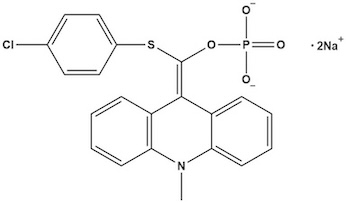| Synonym: | Sodium ((4-chlorophenyl)thio)(10-methylacridin-9(10H)-ylidene)methyl phosphate |
| CAS #: | 193884-53-6 |
| Molecular Formula: | C21H15ClNO4PS•Na2 |
| Molecular Weight: | 489.8 |
| APS-5 is a proprietary acridan-based chemiluminescent substrate designed for the detection of alkaline phosphatase (AP) conjugated molecules in enzyme-linked immunosorbent assays (ELISA), Western blotting, and other biochemical assays. APS-5 is widely recognized for its high sensitivity, rapid signal generation, and temperature insensitivity, making it a valuable tool in life science research and diagnostic applications. 1. Chemical Composition and Mechanism APS-5, with the chemical formula C21H15ClNO4PSNa2 (CAS Number: 193884-53-6), is a 9,10-dihydroacridine-based chemiluminescent substrate. It is specifically engineered to interact with alkaline phosphatase (AP), an enzyme commonly used as a label in immunoassays. When AP catalyzes the dephosphorylation of APS-5, it triggers a chemiluminescent reaction that rapidly releases photons, with peak light emission at approximately 450 nm. The proprietary acridan chemistry enhances the efficiency of this reaction, resulting in a high signal-to-noise ratio and sustained luminescence compared to traditional dioxetane-based substrates like Lumi-Phos 530 and Lumi-Phos Plus. The reaction mechanism is optimized to achieve maximum light output within seconds of substrate addition, with the signal remaining stable for extended periods, reducing the need for precise timing during measurements. Additionally, APS-5 is designed to be temperature-insensitive within a range of 22–35°C, ensuring consistent analytical results without stringent environmental controls. 2. Performance Characteristics 2.1 Sensitivity APS-5 is noted for its exceptional sensitivity, capable of detecting alkaline phosphatase at concentrations as low as 10^-8 U, with a dynamic range extending to 10^-4 U. This makes it suitable for detecting low-abundance analytes in complex biological samples, such as those encountered in ELISA and Western blotting applications. The substrate’s ability to produce a high-intensity signal with low background noise enhances its utility in high-sensitivity assays, including single-copy gene detection in nucleic acid assays. 2.2 Speed One of the standout features of APS-5 is its rapid peak intensity. The substrate reaches its maximum light output within seconds of AP addition, significantly reducing assay times and increasing throughput. This is a marked improvement over dioxetane-based substrates, which often require longer incubation periods to achieve comparable signal strength. 2.3 Stability APS-5 exhibits robust stability under recommended storage conditions. When stored at 2–8°C in the dark, the substrate remains stable for over a year, as noted by manufacturers. The working solution, once prepared, can be aliquoted and stored at -80°C for up to six months or at -20°C for one month without significant loss of activity, provided it is protected from repeated freeze-thaw cycles and strong light exposure. Some users have reported the formation of crystals at the bottom of refrigerated bottles, which dissolve upon warming to room temperature (22–35°C) without affecting performance. 2.4 Temperature Insensitivity Unlike many chemiluminescent substrates that require precise temperature control to maintain consistent signal output, APS-5 delivers reliable results across a temperature range of 22–35°C. This feature simplifies assay protocols and reduces the need for specialized equipment, making it particularly advantageous in laboratories with variable environmental conditions. 2.5 Linear Calibration The luminescence intensity of APS-5 is directly proportional to the concentration of alkaline phosphatase within its dynamic range, enabling the generation of linear calibration curves. This linearity facilitates accurate quantification of analytes, making APS-5 a preferred choice for quantitative assays. 3. Applications APS-5 is versatile and widely used in various research and diagnostic applications, including: • ELISA Assays: APS-5 is a preferred substrate for detecting AP-conjugated antibodies in ELISA, offering superior sensitivity and speed. It is commonly used in clinical diagnostics for detecting tumor markers, infectious diseases, hormones, and endocrine functions. • Western Blotting: The substrate’s high sensitivity and low background make it ideal for chemiluminescent detection of AP-labeled proteins on membranes, providing clear visualization of protein bands. • Nucleic Acid Detection: APS-5 supports direct and indirect detection of AP-labeled nucleic acids in Southern blotting and other hybridization assays, enabling single-copy gene detection. • Phosphatase Activity Assays: Researchers use APS-5 to assess alkaline phosphatase activity in solution, leveraging its rapid signal generation and wide dynamic range. • Bacterial Monitoring: Studies, such as one published in the Journal of Food Science (2008), have demonstrated the use of APS-5 in bacterial alkaline phosphatase assays for rapid monitoring of bacterial counts on spinach, highlighting its utility in food safety research. 4. Comparison with Other Substrates APS-5 is often compared to other alkaline phosphatase substrates, such as Lumi-Phos 530 and Lumi-Phos Plus. Key differences include: • Lumi-Phos 530: This dioxetane-based substrate is 10,000 times more sensitive than colorimetric substrates in solution but requires longer incubation times to reach peak intensity (approximately 27 minutes for 90% maximum light output at 37°C). Its emission maximum is at 530 nm, compared to APS-5’s 450 nm. While Lumi-Phos 530 is robust, APS-5 offers faster signal generation and greater ease of use. • Lumi-Phos Plus: This substrate includes a patented enhancer, improving its signal-to-noise ratio compared to Lumi-Phos 530. However, APS-5’s acridan chemistry provides superior speed and temperature insensitivity, making it more suitable for high-throughput applications. • Colorimetric Substrates: Traditional colorimetric substrates, such as p-nitrophenyl phosphate (pNPP), are significantly less sensitive than APS-5 and lack the rapid signal generation and dynamic range required for ultra-sensitive assays. Compared to these alternatives, APS-5 stands out for its speed, sensitivity, and temperature insensitivity, making it a preferred choice for researchers prioritizing efficiency and accuracy. 5. Limitations While APS-5 is highly effective, it has a few limitations: • Light Sensitivity: The substrate is highly sensitive to light exposure, which can increase background signals and reduce assay accuracy. Strict adherence to dark storage conditions is necessary. • Cost: As a proprietary reagent, APS-5 may be more expensive than generic colorimetric substrates, which could be a consideration for laboratories with budget constraints. 6. Storage and Handling Recommendations To maximize the performance of APS-5, the following storage and handling practices are recommended: • Storage: Store at 2–8°C in the dark to maintain stability for over one year. For working solution, aliquot and store at -80°C for up to six months or -20°C for one month. • Handling: Avoid exposure to strong light, as even short exposures can increase background signals. If crystals form during refrigeration, warm the solution to 22–35°C to dissolve them before use. • Preparation: Prepare working solutions fresh or store them appropriately to avoid degradation from repeated freeze-thaw cycles. APS-5 is a highly effective chemiluminescent substrate for alkaline phosphatase detection, offering unmatched sensitivity, rapid signal generation, and temperature insensitivity. Its versatility across ELISA, Western blotting, and nucleic acid detection, combined with its robust performance and positive user feedback, makes it a top choice for researchers in life sciences and diagnostics. While it requires careful handling to avoid light exposure and is limited to research use, its advantages in speed, sensitivity, and ease of use outweigh these considerations for most applications. Compared to alternatives like Lumi-Phos 530 and Lumi-Phos Plus, APS-5’s acridan-based chemistry provides superior performance, particularly in high-throughput and time-sensitive assays. For researchers seeking a reliable, high-performance substrate for AP-based assays, APS-5 is an excellent option that delivers consistent, reproducible results. Its widespread adoption in the scientific community and strong track record in peer-reviewed studies underscore its value as a critical tool in biochemical research. |
|
APS-5
For Research & Development use only. Not for testing and/or use on humans.



